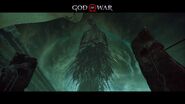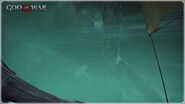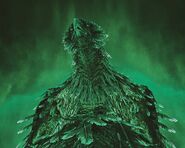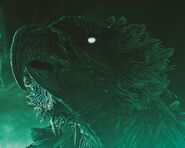This article contains lore based on real-life sources from Norse Mythology as introduced from the God of War Norse Era.
| “ | We have spoken to the eagle that presides here in Helheim. She watched from afar while I battled the Bridge Keeper in our prior journey. Now, by releasing Garm, we have opened six tears to Helheim. Hræsvelgr is not pleased, but does not appear to be our enemy. That is for the best. | ” |
–Kratos' thoughts about Hræsvelgr | ||
Hræsvelgr is a Jötunn who appears in God of War (2018) and God of War Ragnarök. She is the current ruler of Helheim, also known by her title of "Hel", being perched atop its tallest building and gazing down upon the Realm and its residents.
Norse Mythology[]
In Norse mythology, Hræsvelgr (Old Norse "Corpse Swallower") is a giant who takes the form of an eagle.
According to stanza 37 of the poem Vafpruonismal from the Poetic Edda, he sits at the end of the world (or the northern edge of the heavens) and causes the wind to blow when he beats his wings in flight. This is repeated by Snorri in the Gylfaginning section of his Prose Edda.
Biography[]
God of War (2018)[]
Hræsvelgr is the ruler of Helheim and is thus known as "Hel". When Kratos travels to Helheim to claim the Bridge Keeper's heart in order to cure his son, she remains indifferent to all the events she witnessed. During the flying ship section, she can be seen again but this time flapping her wings.
God of War: Ragnarök[]
After defeating Garm, Kratos and Atreus talk to her in order to find out how many Hel Tears were opened by Garm's rampage. Hraesvelgr told Atreus there were six Tears to be closed and also made it clear he should not expect any thanks, as the Tears shouldn't have been opened in the first place. Later on, Mimir tries to tell Hraesvelgr about their success in closing all the Tears, but the Eagle of Hel is already well-aware of it, and simply tells him like she said to Atreus, there is no reward for closing them.
Before launching their war to bring down Odin, Kratos and his allies decide to request Hræsvelgr in lending them the forces of Hel. Hildisvíni decides to take Mimir along for the negotiation when Kratos and Atreus seek out Surtr, since Mimir had already died once and she would be more agreeable to such a person. They managed to convince her by promising to find someone to take her place as the ruler of Helheim so she can retire.
Gallery[]
Trivia[]
- It's possible that Hræsvelgr is the one who responsible for causing Helheim to be in a state of permanent deep-freeze, as her mighty wings flapping could be what causes the severe cold winds blowing unceasingly like it does in Norse Mythology.
- Her lore marker also supported this idea, as it is said she is "the author of the winds".
- Hræsvelgr's lore marker noted that she is the ninth ruler of Helheim, with her tenure lasted for the longest.
- Like Jörmungandr, Hræsvelgr speaks an ancient language used by the Jötunn that only a few like Atreus and Mimir can understand.
- In the game, she is a female. However, in the original Norse Mythology, Hræsvelgr is a male.
- As revealed in the model, she has four wings and her proportions are quite different from a regular eagle.
- If one looks in the background during the section on the flying ship, Hræsvelgr can be seen relentlessly batting her four wings as the ship sails (unlike normal Helheim events where she just sits still), implying that her wings are providing the ship's momentum.
- It is unknown why neither Kratos, Atreus, or Mimir acknowledged Hraesvelgr during their escape from Helheim. While Kratos has encountered so many things a giant bird is nothing too impressive to him, Atreus's reasoning are unclear, despite his enthusiasm and his shift in personality after realizing he was a god, although it's likely that with how much Atreus has angered Kratos and Mimir, he probably decided not to make any unnecessary comments. As for Mimir's reasoning, it's quite likely that he is worried of how Hraesvelgr would react to his presence, as he is technically still dead, only reanimated, and may have been hoping Hraesvelgr would not raise any unnecessary conflict over it.
- Mimir's reasoning is made more likely by how Hildisvíni requested his presence to help in working things out with Hraesvelgr and how Mimir is shown to be particularly careful of Hraesvelgr in God of War Ragnarok. It is also notable that if Mimir is the one to ask Hraesvelgr about the Realm Tears, Hraesvelgr talks to him noticeably more irritatedly than she would with Atreus, further supporting the idea that she is against resurrections.
- It is unknown why neither Kratos, Atreus, or Mimir acknowledged Hraesvelgr during their escape from Helheim. While Kratos has encountered so many things a giant bird is nothing too impressive to him, Atreus's reasoning are unclear, despite his enthusiasm and his shift in personality after realizing he was a god, although it's likely that with how much Atreus has angered Kratos and Mimir, he probably decided not to make any unnecessary comments. As for Mimir's reasoning, it's quite likely that he is worried of how Hraesvelgr would react to his presence, as he is technically still dead, only reanimated, and may have been hoping Hraesvelgr would not raise any unnecessary conflict over it.
- Her desire to leave her post in Helheim, which is only possible if someone takes her place there, makes Hræsvelgr similar to the Titan Atlas, who was cursed to eternally hold up the sky and could only resign himself from that fate if someone were to hold up the firmament for him.
- The difference between the two is that while Atlas's position as a literal pillar for the Greek World was a punishment for him siding with the Titans on the Great War, apparently, Hræsvelgr's position as Helheim's ruler was something she willingly took after the previous Helheim's ruler had to abandon the position. In short, while Atlas was punished, Hræsvelgr chose to become Helheim's ruler.
- Her conceptual art makes a nod to Atlas.
- Both are before a world where the dead walk. Atlas before Elysium and Hræsvelgr before Helheim.
- Both have a gigantic appearance.
- Both have 4 arms which are extended.
- The two are standing on top of a pillar.
- In the illustrations, they dominate the color red and cyan, curiously both are opposite colors.
- She was meant to be a boss in God of War (2018) but was cut.









